This week marks the 35th anniversary of an attraction that is still finding new fans today. Horizons closed nearly 20 years ago, yet many of us still regularly talk about this remarkable attraction. Some never actually experienced it in person, which makes the love for Horizons more surprising. It represents the soul of EPCOT Center and what’s been lost, especially in the past decade. To honor my favorite attraction, I’m digging further into why it succeeded. This article is all about an undervalued part of Horizons, its inventive transitions between scenes.
When we talk about classic dark rides, it’s easy to focus on highlights. Show-stopping moments remain in our memories for years. What makes those scenes work are transitions that set up the big moments. On Pirates of the Caribbean, part of what makes the battle between the fort and the pirate ship so exciting is the set-up. We drop down the waterfall and land inside the action-packed fight. Energetic music plays after the fun drop, and the stage is set for one of Pirates’ great moments.
Horizons’ transitions aren’t so dramatic, but they are equally important. The mix of music, narration, and physical sets must work together or risk taking our minds outside the attraction. Another good example is the opening climb inside the Jeremy Irons version of Spaceship Earth. After the AT&T welcome, audio clips play of famous moments in communication. Our time machine vehicles venture into the dark with only small lights guiding our path. Irons’ voice introduces the experience while lightning strikes flash from the upcoming scene. We’re enthralled by the mysterious tone of Irons’ words and the quiet start to our journey. Everything works in that version of Spaceship Earth because we slowly venture into a different space.
Horizons’ Prologue and Opening Transitions
In a similar vein to Spaceship Earth, Horizons sets the stage for the experience right at the start. The transition actually happens even earlier in this case from the moment you enter the building. We step through the automatic doors, and George Wilkins’ brilliant theme “New Horizons” greets us while we traverse the queue. The song is warm and inviting, with children’s voices belting out the simple message “if you can dream it, then you can do it, yes you can!” I cannot understate how important that song is to create the right mood for the attraction.
The queue also provides glimpses of futuristic wonders that we will visit on Horizons. We stroll down the comfortable walkway and see Bob McCall’s gorgeous images of the Sea Castle floating city, Mesa Verde desert haven, and Brava Centauri space colony. Designed by Gil Keppler, this queue is a brilliant example of elegant design and place making. We are now more engaged in this journey before we even board our unique Omnimover vehicles. This is not a lavish queue, but subtle touches match the attraction’s graceful tone. It is a comfortable, warm space.
After stepping onto the moving walkway and boarding our vehicles, we don’t immediately dive into the story. We are clear for departure into the 21st century, and the grandmother and grandfather narrators start chatting. We see colorful clouds that again give us a moment before taking us into the main presentation. Grandfather hints at the wonders to come with these words: “Wait’ll you see the new towns of tomorrow. Desert farms and floating cities — even colonies in space.” In a similar way to queue’s images, this message effectively sets up the upcoming scenes. As we slowly begin “Looking Back at Tomorrow”, we are completely on board for the experience.
Bringing Dreams to Life in the Omnisphere
After enjoying the future in the 1950s, our vehicles arrive in the present day of 1983. We can’t just skip from past visions into modern technology, however. That would be too jarring and lose creative momentum. Just think at how you feel during Under the Sea: Journey of the Little Mermaid with the scenes crammed together near the end. Horizons is too good to include awkward transitions between eras. Instead, we journey into a simple hallway that gives us a moment to anticipate the next transition.
Curtains line the walls inside this entry tunnel, and dimmed red lights provide a calming break. YouTube videos fail to convey the relaxing feeling within these spaces. These small transitions are some of my clearest memories from Horizons. Grandfather’s words help us to move from zany visions of the past to a grand look at the possibilities with today’s technology:
“The only difference is that today, with what we know and what we’re learning to do, we really can bring our dreams to life. It takes a lot of work, but the truth is, if we can dream it, we can do it.”
Setting aside the commercial for GE, these lines present an optimistic view of what is possible if we work together. That inspiring theme is everywhere in the original EPCOT Center. Grandmother confirms the point with her reply that “Tomorrow’s horizons are here, today”. The music has changed from whimsical fun to quiet wonder, and that background combines well with the atmosphere inside the entry tunnel. As we exit into the Omnisphere and travel up and past the screen, we are ready for the majestic excitement of the space shuttle, a DNA strand, and other modern marvels.
A Journey to Tomorrow’s Windows
As we exit the Omnisphere, it’s easy to think that nothing can top that experience. We are really just getting started, however. A second tunnel gives us another break to get reoriented before visiting the future. The optimistic music and dimmed red lights are back to provide the right transition into the next chapter. The spectacle is over, and now it’s time for a down-to-earth connection with how life might actually happen in the future. Grandfather sets the stage:
“What you’ve just seen are the building blocks for the future up ahead. And while it may look fantastic, remember, it’s all possible. Come on, take a look at 21st century living: on land, at sea, and even out in space. But let’s start off at our place.”
When we venture into “Tomorrow’s Windows”, the music style changes again to a mix between whimsy and wonder. This is not the epic scale of the Omnisphere or the silliness of the ’50s sequences. Instead, we visit a place that looks fun but also connects to our reality. The choice of a living room for the first scene ensures that we understand the shift towards personal stories. The message of Horizons is about more than space shuttles and floating cities. The experience reveals the possibilities for our daily lives. The final transitions back to the FuturePort come through the inventive “choose your ending” conclusion, which makes the experience feel different each time.
Horizons’ Classic Theme Park Design
Every time I revisit Horizons, I’m reminded why its influence remains strong now. We all have nostalgia for classic EPCOT Center, and that is a small part of it. What surprises me about Horizons is how vibrant it feels when compared to other attractions from the early ‘80s. This experience stands alongside The Haunted Mansion and Pirates of the Caribbean as a prime example of brilliant attraction design. Imagineers Claude Coats, George McGinnis, Tom Fitzgerald, and others found brilliant ways to work around budget cuts and deliver a show that supersedes its parts.
It is easy to look back at Horizons as a relic from a different theme park era that could not succeed today. I don’t buy that explanation. When an attraction has effective design and a convincing theme, guests will respond because it just feels right. The best Disney attractions possess that quality, which transcends any specific eras. With a few updates here and there, Horizons would sit comfortably among more recent attractions in Epcot. The brilliant transitions represent just one example of why this attraction remains so prominent in our hearts. Thirty-five years later, Horizons still represents one of the finest examples of the potential for theme parks.
Sources: Horizons1 (script); Martin’s Complete Ultimate Tribute: Horizons; From Horizons to Space Mountain: The Life of a Disney Imagineer by George McGinnis
Stay updated on all the latest blogs and podcasts; join The Tomorrow Society today!
Related Articles – Horizons
EPCOT Center’s Horizons: Why It Worked
Horizons and Legitimate Nostalgia
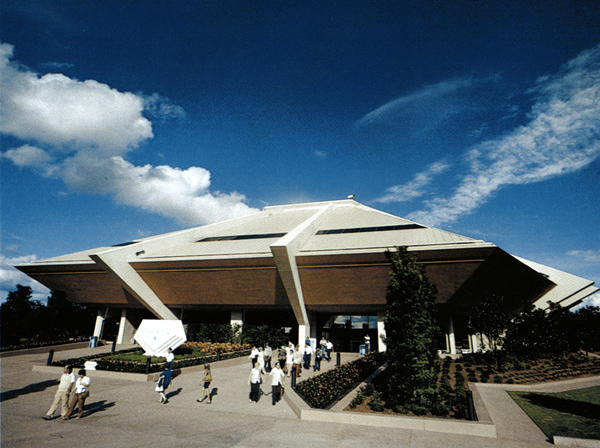
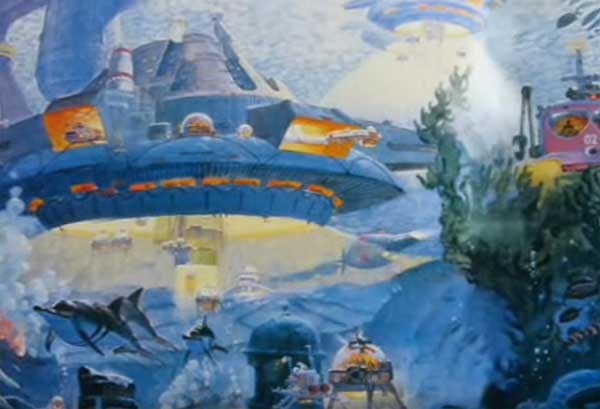
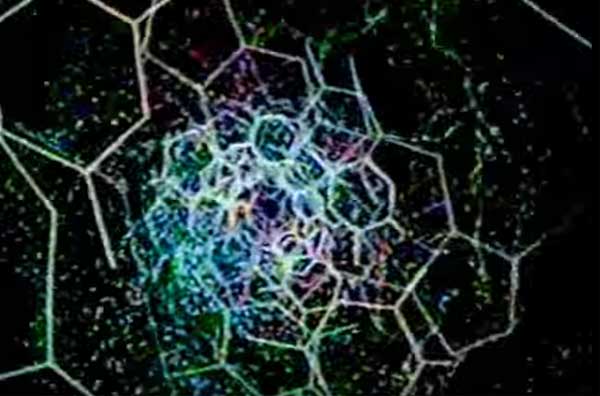
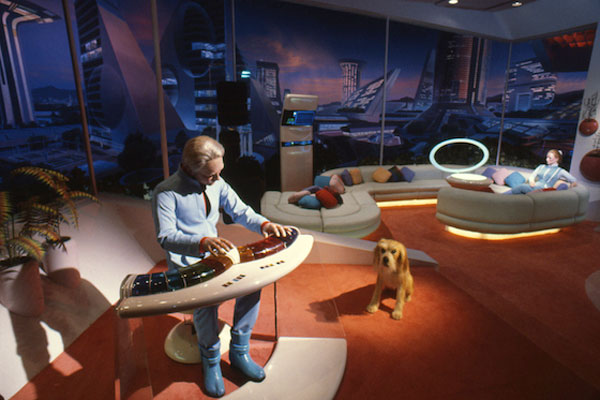
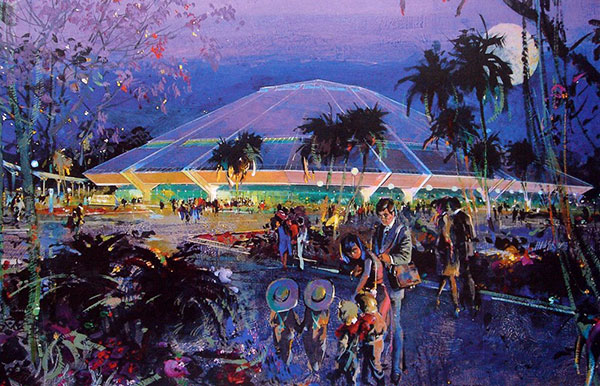
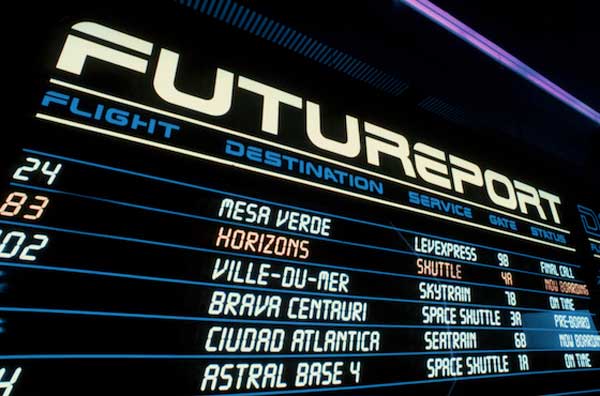



Loved this article. I’ll never forget that first ride on Horizons– just getting into the strange, sideways-moving vehicle sent shivers of expectation through you. I believe my whole five-member family could fit in one vehicle. That transition into the Omnimax theater was so unexpected and wonderful. How I yearn for the optimistic embrace of Horizons when I am reeling from the terrible problems in the world today. I bought a copy of “Music from Disneyland, Magic Kingdom, and Epcot” on CD at a library sale last year and was really taken back by hearing the Horizons song for the first time in decades. I had forgotten it, and it’s so emotional for me. Okay, not as emotional as “Tomorrow’s Child,” (that’s like emotional break-down level) but a lovely look back!
Melanie, I have fond memories of our entire family of five riding in Horizons when I was a kid. We battled over choosing the ending, and I felt like we always ended up with the desert somehow (which made no one happy). I’m very familiar with the CD you mentioned, which gets a lot of plays on my iPod. I’ve also spent more time thinking about the message of those past attractions and just the park in general with all the awful news happening right now. I’m glad some remnants like Living with the Land and Spaceship Earth (with no Tomorrow’s Child, sadly!) are there, but it’s still doesn’t feel the same overall.
You and I are both children of classic Epcot center, Dan! The message of that once-inspiring place continues to blaze in our hearts– we can fix the messes we’ve made. We can get along, as a world of diverse nations, in harmony. We can discover new technologies and secrets of nature to ensure that all people can live and work in good health and safety. Even as a child I felt these feelings, my spirit soaring and my optimism unshakable. It was a very different kind of happiness than the type you’d get from Splash Mountain or the Jungle Cruise. Those were pleasant and lovely, but Epcot was a place with a mission, a place of Real Things that were every bit as captivating as the Magic Kingdom’s worlds of fantasy. And there in the corner of Future World was Journey Into Imagination, a wonderful, wacky, earnest reminder of where all the other pavilions came from– the limitless scope of the human creative mind. My soul cries for those who were born too late to experience it! And you and me brother can only close our eyes and remember. Thank you for helping keep the memory alive with your wonderful articles.
So well said, Melanie! I loved the way that EPCOT Center looked at real issues but still did it in a way that was fun. It never felt boring, even when I was a kid. There are still parts of the current Epcot that work in that way, especially Living with the Land and the ascent of Spaceship Earth. So much has been lost, though! Thanks for the great comment, and I’m thrilled that you enjoyed the article.